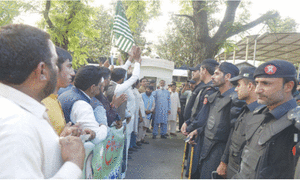Abbottabad town has acquired infamy as the last home of Osama Bin Laden and the location of the daring US Navy Seals Operation that riveted the world. Even as the news reports dry out, it will still remain the subject of many a documentary (and Hollywood film to be sure) in the months and years to come. Now that everyone is talking about Abbottabad, perhaps it is a good time to bring up all the cultural and environmental destruction that has taken its toll over the years on this historical and once pleasant hill station.
A couple of years ago, after the massive earthquake hit this region (Abbottabad was spared large scale devastation but many old buildings were damaged) I was alerted to the plight of the historical buildings in Abbottabad by the Sarhad Conservation Network. Based in Peshawar, this network of architects, doctors, NGO activists and other concerned citizens of Khyber Pukhtunkhwa pointed out that government institutions like the Earthquake Reconstruction and Rehabilitation Authority (ERRA) were pulling down these historical buildings (which could have been repaired with funding from donations) and replacing them with ugly, concrete and plaster blocks that are to be found everywhere in Pakistan. The chiselled stones and expensive wood used in the construction of the older buildings would be auctioned off and lost forever. Then there were all the old trees that Abbottabad was originally famous for — as these buildings disappeared so would the massive trees such as chinar, mahogany, camphor and deodar that had been planted around them in their gardens and green belts.
Actually this wanton destruction had started long before the earthquake, for Mahmood Aslam of the Sarhad Conservation Network notes that “During the past few decades, several attempts were made by the ‘commissions’ of structural and conservation experts of the municipal committee Abbottabad to demolish these ‘dangerous’ buildings”. Why were these government officials out to destroy these charming old buildings? The reasons were simple: “They get expensive seasoned timber, heavy gauge roof sheets, chiselled stones and antique building items for their private bungalows; they make huge money from kickbacks, bribes, commissions, shares, etc. from sham contractors during the reconstruction phase”.
How sad that the answer was just plain greed. Indeed, those of us who visited Abbottabad during our childhood years can today barely recall those verdant tree lined avenues and colonial bungalows with spacious gardens as the town has become a polluted, overcrowded concrete maze of shops and homes. The only pockets of old trees and charming buildings probably still remain in the army controlled parts of town which are now off limits to outsiders due to security reasons. For those who argue why we should preserve our colonial heritage since Abbottabad was built by the British colonial power in 1853, I would remind them that several leaders from the Pakistan Movement also had homes in Abbottabad like Sir Sahibzada Abdul Qayyum. According to Mahmood Aslam, “As Sahibzada sahib had no child of his own, his bungalow is in the custody of the unreliable ‘auqaf’ department and some fake relatives were trying to bribe officials to grab and demolish that important place where most of the important meetings for the creation of Pakistan were held”. His guesthouse where leaders from the Pakistan Movement came to stay has already been demolished.
All around the world towns and cities are proud to save their heritage but in Pakistan we are in a hurry to destroy what remains. Still some brave individuals fight on and I came across one who had posted photos of several destroyed historical buildings of Abbottabad on a website. This anonymous “engineer” who belongs to Abbottabad writes: “We mourn the slow death of Abbottabad, which was once an unforgettable experience for heads of states, commander-in- chiefs, poets, statesmen, writers, and thousands of nature loving souls… Abbottabad was once considered the most beautiful, greenest and artistically built town of the Subcontinent. It had avenues of horse chestnuts, Lebanese and Himalayan cedars, pines, maples (chinars), ash, elm, camphors, walnuts, etc. The trees of Abbottabad were brought from all over the world.”
According to architect and conservationist Yasmeen Cheema who visited Abbottabad after the earthquake of 2005, “Abbottabad town was built on marshy ground, therefore a lot of the old buildings were damaged during the earthquake. But aside from the corps commander’s house which really had to be demolished, I think the other buildings should have been saved”. She has written a book called Relishing histories of earthquake areas which is soon to be published. In the book, she details what can be done in terms of retrofitting and conserving some of the old buildings of Abbottabad.
With devolution and the passing of the 18th Amendment, it is now the responsibility of the provincial and local governments to conserve these buildings and landscapes. Buildings of historical importance should not only be saved but they should have plaques placed outside them to inform and educate the public. Abbottabad might no longer be a pleasant hill station but the town can still preserve what is left of its heritage if it wants to be remembered for more than just being Osama’s last hideout.
As an old native American saying goes, “If you don’t know where you are coming from, you don’t know where you are going”.















































